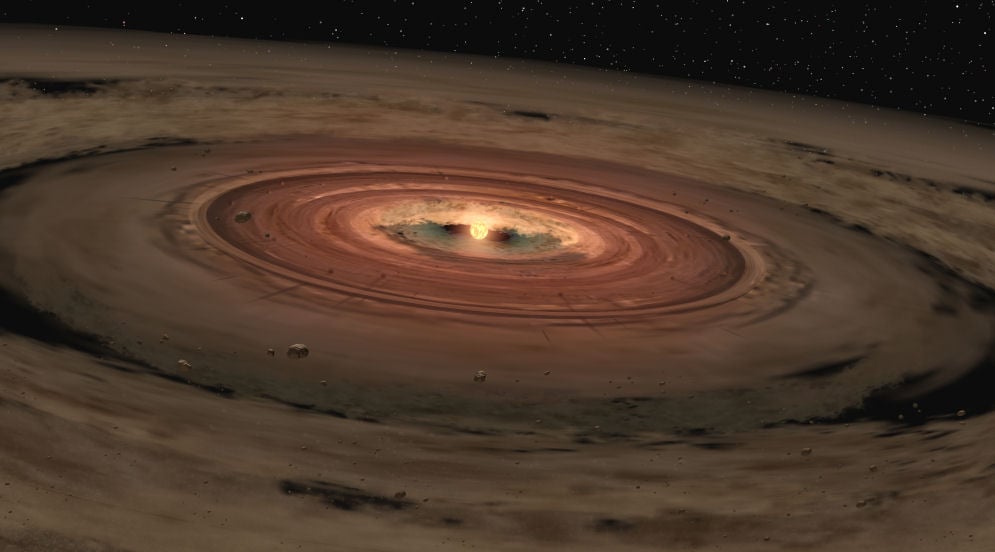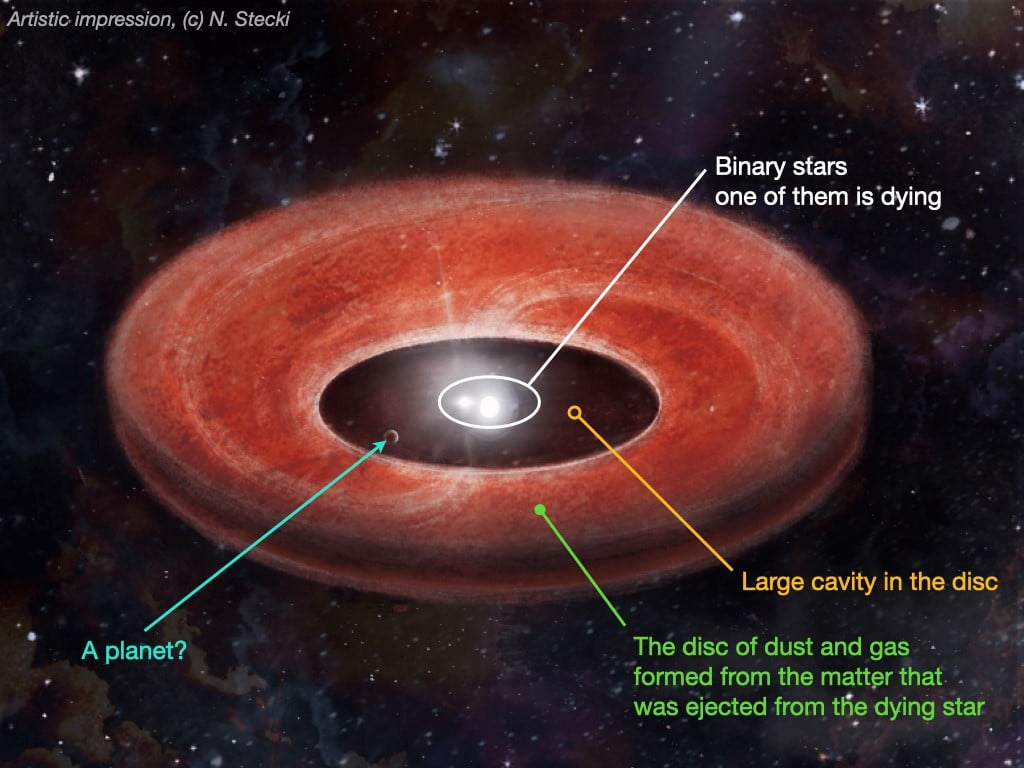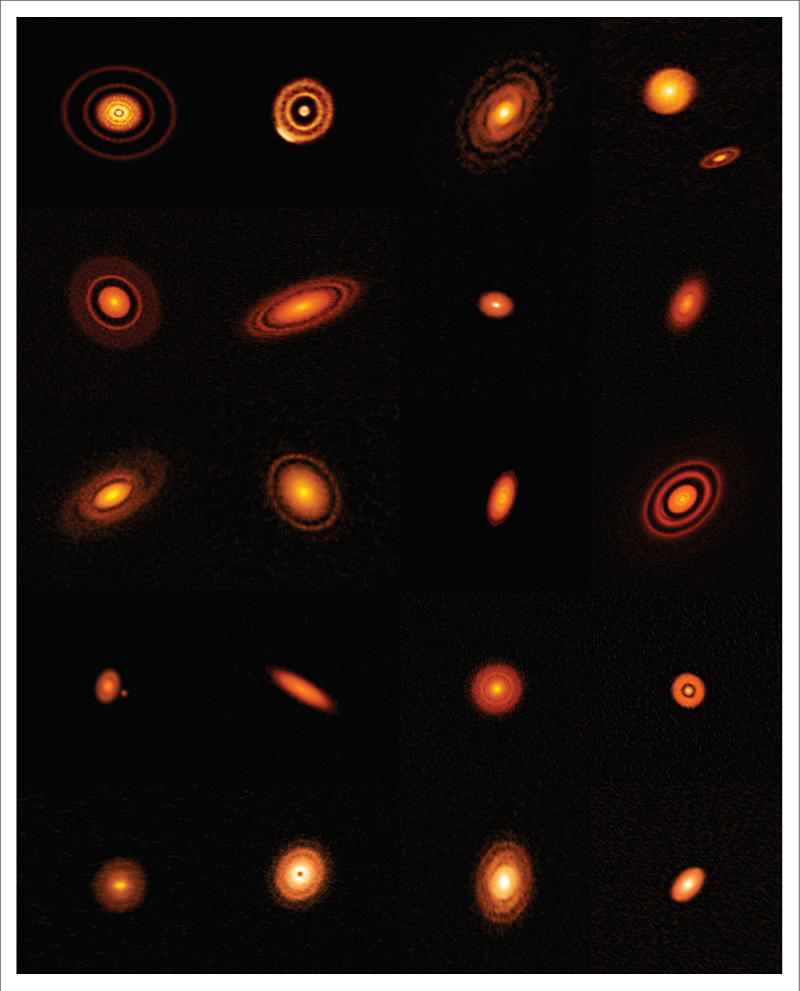When young stars coalesce out of a cloud of molecular hydrogen, a disk of leftover material called a protoplanetary disk surrounds them. This disk is where planets form, and astronomers are getting better at peering into those veiled environments and watching embryonic worlds take shape. But young stars aren't the only stars with disks of raw material rotating around them.
Some old, dying stars also have disks. Can a second generation of planets form under those conditions?
Planets form after stars form, but not long after. In our Solar System, the Sun formed about 4.6 billion years ago and the Earth about 4.5 billion years ago. Earth's fate is entwined with the Sun's fate. When the Sun expands as a red giant, it will expel layers of material into space and eventually expand enough to destroy the Earth and the other inner planets. Jupiter and the outer planets will survive, but they'll likely spend the rest of their existence orbiting a white dwarf, the Sun's remnant. No new planets can form around the white dwarf in this scenario.
But our Sun is a relative rarity. Many stars exist in binary pairs. Binary stars are the same age, but they have different masses. Since a star's initial mass determines its future, the stars in a binary pair have different lifespans. If one of those stars has a similar mass as our Sun, it becomes a red giant and expels material out into space as it dies. What happens to all that material if the star has a binary partner?
This is where a new study comes into the picture. Its title is " A population of transition disks around evolved stars: Fingerprints of planets. " The first author is KU Leuven astronomer Jacques Kluska. The journal Astronomy and Astrophysics published the paper.
The gravitational pull of the second star can cause the ejected material from the dying star to form a new rotating disk very similar to the protoplanetary disk around the star when it was young. Astronomers already knew this could happen. What's new is the evidence that a second generation of planets can form in the disk. According to this new study, new worlds are forming around 10% of binary stars in this situation.
"In ten percent of the evolved binary stars with discs we studied, we see a large cavity in the disc," said first author Kluska in a press release. "This is an indication that something is floating around there that has collected all matter in the area of the cavity."
There's probably only one thing that can form in these disks: planets. Observations of the dying star strengthen the likelihood of the object being a planet. "In the evolved binary stars with a large cavity in the disc, we saw that heavy elements such as iron were very scarce on the surface of the dying star," said Kluska. "This observation leads one to suspect that dust particles rich in these elements were trapped by a planet."
Astronomers aren't sure if these are planets yet, but the evidence is intriguing. If it turns out that a second generation of worlds is forming in this way, it's a significant discovery. It means that our theory of planetary formation, called the nebular hypothesis, is correct but doesn't go far enough.
"The confirmation or refutation of this extraordinary way of planet formation will be an unprecedented test for the current theories," according to Professor Hans Van Winckel, head of the KU Leuven Institute of Astronomy.
These disks can only form in certain circumstances and with certain types of stars. It requires post-asymptotic giant (post-AGB) stars. Post-AGB stars are cool, luminous stars in a stage of stellar evolution that stars like our Sun go through. The mass range for post-AGB stars is from about 0.8 to 5 solar masses.
Post-AGB stars have exhausted their supply of hydrogen. The star's core is mainly inert carbon and oxygen, but its outer layer expands and cools. The star becomes a red giant. Then the changing temperature in the star's core triggers helium fusion. The fusion delays the star's cooling and expansion for a while, but eventually, the helium runs out, too. Then the cooling and the expansion continue.
The star's not finished yet. It experiences some thermal pulses and fuses some more hydrogen, and experiences some helium flashes. But the star has lost a lot of its mass by shedding it into space. If it has a binary partner, the material doesn't go far. The binary pair will have a center of gravity, and the ejected material will form a circumbinary disk around the center.
This doesn't always happen. A common and dramatic spiral-in phase of binary evolution causes the partner star to accrete the material from the dying star. But for some reason that astronomers don't understand yet, a circumbinary disk can form instead. That's what happened in 10 % of the binaries in this study.
These post-AGB disks don't last very long, only between 10,000 and 100,000 years. Is that long enough for a giant planet to form? Astronomers didn't use to think so. But more recent research suggests planets can form in only 100,000 years. One study from 2018 examined gaps in disks and said that "... if planets are indeed carving these gaps then Saturn-mass planets must form within the first ~0.5 Myr of the lifetime of protoplanetary disks."
But the authors of this study say that even if the cavity in the disk is from a planet, that planet might not necessarily be a second-generation planet. "However, it seems more plausible that if the transition disks were produced by a planet, it would be a first-generation planet that survived the binary interaction phase," they write. "Indeed, it seems that circumbinary planets are as frequent as planets around single stars, despite the relatively low number of detections."
This conclusion also fits with some of the observed properties of the dying star in the system. As the lead author Jacques Kluska pointed out, "... we saw that heavy elements such as iron were very scarce on the surface of the dying star."
What happened to the iron? The surviving first-generation planet could've accreted it, but only if it were a giant planet. "If such a planet is present from the start in the disk, it will efficiently deplete the inner disk from refractory material and produce the depletion pattern observed on the surface of the star," the authors write in their paper.
Astronomers already know of a binary system where secondary planets have likely formed. It's called NN Serpentis, and multiple researchers have found planets there. "These planets are candidates for having been formed in such second-generation disks," Kluska and his co-authors write. "If the planetary scenario is confirmed, these disks would become a promising site for studying second-generation planet formation and, hence, planet formation scenarios in an unprecedented parameter space."
The authors intend to study the ten disks that show cavities. They plan to use the European Southern Observatory's large telescopes in Chile to study them more closely.
More:
- Press Release: Even dying stars can still give birth to planets
- New Research: A population of transition disks around evolved stars: Fingerprints of planets
- Universe Today: Planets Form in Just a Few Hundred Thousand Years
 Universe Today
Universe Today


